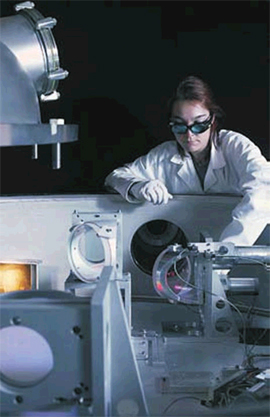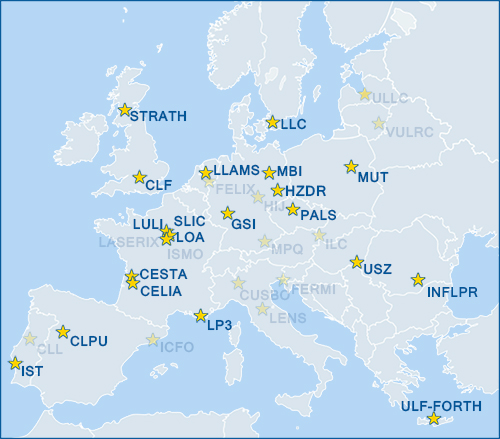LEPP - Laser-driven High Energy Photon and Particle Sources towards Industrial and Societal Applications
 |
|---|
| Experimental set-up for laser-proton acceleration |
The overarching objectives of this JRA are (i) to optimize secondary high energy sources for specific and well identified applications of high industrial and societal relevance; (ii) to contribute to the implementation of proof of principle experiments/set-ups in EU facilities to test some of the most promising concepts/applications; (iii) to leverage on national activities to shape and to focus the European landscape on applications of laser driven high energy photons and particle sources.
The synergistic collaboration between the partners within the JRA will exploit not only the existing experimental facilities, including dedicated beamlines for biomedical studies, and world leading know-how but also the wide network already established with SMEs, industrial companies and hospitals/clinics by the teams participating in this JRA. They are in an outstanding position since the interactions and the bridges with the stakeholders for these applications have now become mature.
The main goals of each task are:
Task 1: Radiotherapy and radiobiology applications of laser based electron accelerators
Radiobiological studies of high dose rates using electron beams are now possible, and it is possible to extend these studies beyond the proof-of-principle studies already developed (e.g. for prostaste tumours). Therefore, this task will address the use of high energy electrons for the other relevant clinical scenarios, and their comparison with standard techniques, leveraging on the significant expertise in Laserlab in these developments (e.g. IMRT, fraction issues, dosimetry) and well established collaborations with medical researchers and clinicians. The outcome of these studies will contribute to identify and to optimize the relevant applications of the laser driven electron beams in radiotherapy and radiobiology.
Task 2: Development and applications of compact light sources for imaging
The properties of the betatron, Compton and HHG x-ray sources make them ideal candidates for imaging in a wide range of applications. This task will address the application of these sources for nanoscale imaging, and for tumour and biomedical imaging. This task will also address the combination of other high energy sources with x-rays for imaging applications. LASERLAB-EUROPE has already several partners contributing to this topic and expertise on using these techniques for bio and/ or nanomaterials research. The outcome of these studies will contribute to establish and to use laser-based spatially coherent x-ray sources, resorting to X ray contrast imaging, for advanced nanoscale and medical imaging techniques with unprecedented properties.
Task 3: Radiotherapy and radiobiology applications of laser based proton beams
In strong connection with task 1, the objective of task 3 is to perform radiobiological studies of high dose rates using either proton beams, with a focus on feasibility studies of laser based protons beam for proton therapy. This is a topic of very high societal relevance as demonstrated by the breadth and the scope of the national programmes, and the JRA will further profit from this and will promote the interplay between the several national projects in Europe and the outstanding advances of the LASERLAB-EUROPE teams. The outcome of these studies will contribute to identify the parameters required for therapy applications and the unique radiobiology properties of the high dose rate deposition associated with proton beams.
Task 4: Advanced instrumentation and targets for applications of laser driven high energy photon and particle sources
The advanced applications associated with this JRA push the state-of-the-art in terms of the technical requirements associated with the characterization and control of the spatial and temporal properties of high-energy radiation and particle laser-driven sources, and the targets required for the high repetition rate high power laser systems to be deployed for the applications to be explored in tasks 1, 2 and 3. Therefore, the main outcomes of this task will be associated with innovative development in optics, detectors, and targets to support the developments required to secondary sources relevant for the key applications of laser driven high energy photon and particle sources. These are also key technologies for facilities such as ELI and XFEL’s.
Coordinator: Marta Fajardo
Participants
 |
|
Industrial partner
SOURCELAB

